

Governor's Community Garden is a public garden, located on the Isle of Portland, Dorset, England. It is found within The Grove village, opposite the site of HM Prison Portland.


Governor's Community Garden is a public garden, located on the Isle of Portland, Dorset, England. It is found within The Grove village, opposite the site of HM Prison Portland.
Following the opening of the prison in 1848, the gardens were laid out in 1851, in the style of a French Palace Garden. They were attached to the prison governor's residence. [1] The publication "Good Words" in 1873 described "a pretty flower garden" with the Governor's house. During the 20th century, the gardens fell into disrepair until in 2010, when the gardens were turned into a new community space, leased by the Portland Community Partnership for use of the public. [2] [3]
In August 2010, the community project was funded by the Big Lottery 'Changing Spaces' administered by Groundwork UK. The Portland Community Partnership and Portland Gas Trust was awarded £46,254 to allow development of the new play area and botanic garden together with publicity and promotion resources. [4] In 2011, the restoration of the garden was awarded a special commendation Weymouth Civic Society Award.
In 2014, the Grove Prison Museum was opened in the former deputy governor's house across from the original gatehouse of the prison. The entrance is located through the gardens. Within the garden lies one of three Victorian ventilator shafts, once used as a ventilator to a sewer system. [5] All three became Grade II Listed monuments in September 1978. [5]

The Isle of Portland is a tied island, 6 kilometres (4 mi) long by 2.7 kilometres (1.7 mi) wide, in the English Channel. The southern tip, Portland Bill lies 8 kilometres (5 mi) south of the resort of Weymouth, forming the southernmost point of the county of Dorset, England. A barrier beach called Chesil Beach joins it to the mainland. The A354 road passes down the Portland end of the beach and then over the Fleet Lagoon by bridge to the mainland. The population of Portland is 12,797.

Portland Harbour is located beside the Isle of Portland, Dorset, on the south coast of England. Construction of the harbour began in 1849; when completed in 1872, its 520-hectare (1,300-acre) surface area made it the largest man-made harbour in the world, and remains one of the largest in the world today. It is naturally protected by Portland to the south, Chesil Beach to the west and mainland Dorset to the north. It consists of four breakwaters — two southern and two northern. These have a total length of 4.57 km and enclose approximately 1,000 hectares of water.
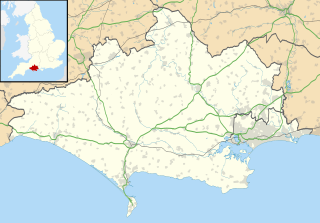
Portland Castle is an artillery fort constructed by Henry VIII on the Isle of Portland, Dorset, between 1539 and 1541. It formed part of the King's Device programme to protect against invasion from France and the Holy Roman Empire, and defended the Portland Roads anchorage. The fan-shaped castle was built from Portland stone, with a curved central tower and a gun battery, flanked by two angular wings. Shortly after its construction it was armed with eleven artillery pieces, intended for use against enemy shipping, operating in partnership with its sister castle of Sandsfoot on the other side of the anchorage. During the English Civil War, Portland was taken by the Royalist supporters of King Charles I, and then survived two sieges before finally surrendering to Parliament in 1646.

Sandsfoot Castle, also known historically as Weymouth Castle, is an artillery fort constructed by Henry VIII near Weymouth, Dorset. It formed part of the King's Device programme to protect against invasion from France and the Holy Roman Empire, and defended the Weymouth Bay anchorage. The stone castle had an octagonal gun platform, linked to a residential blockhouse, and was completed by 1542 at a cost of £3,887. Earthwork defences were built around the landward side of the castle, probably in 1623. Sandsfoot saw service during the English Civil War, when it was held by Parliament and Royalists in turn during the conflict. It survived the interregnum but, following Charles II's restoration to the throne, the fortress was withdrawn from military use in 1665.
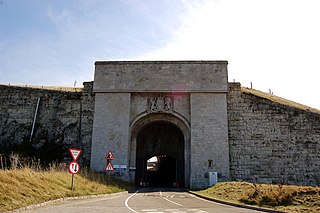
HM Prison The Verne is a Category C men's prison, located within the historic Verne Citadel, on the Isle of Portland in Dorset, England. Operated by Her Majesty's Prison Service, HMP The Verne was established in 1949 and occupies the southern part of the citadel. After a brief spell as an Immigration Removal Centre between 2014–17, HMP The Verne re-opened in 2018.

Church Ope Cove is a small secluded beach on the sheltered eastern side of the Isle of Portland in Dorset, southern England and is part of the Jurassic Coast. It is found close to the village of Wakeham. The beach has many unusual features for the Isle of Portland. The beach used to be sandy, but quarry debris now covers the sand, and has been worn into rounded pebbles. The pebbles cover a small stream which runs to the sea, which is one of the few active streams remaining on the Isle of Portland.
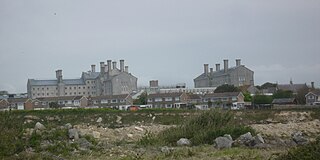
HM Prison Portland is a male Adult/Young Offenders Institution in the village of The Grove on the Isle of Portland, in Dorset, England. It is operated by Her Majesty's Prison Service. The prison was originally opened in 1848 as an adult convict establishment, before becoming a Borstal in 1921, and a YOI in 1988. In 2011 it became an Adult/Young Offenders establishment.
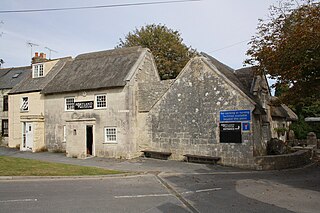
Portland Museum is a museum on the Isle of Portland in Dorset, southern England. It is located at the southern end of the hamlet of Wakeham. The museum is housed in two 17th-century thatched cottages, which have both been Grade II Listed since 1951. One of the museum's cottages, Avice's Cottage, is featured in Thomas Hardy's 1897 novel The Well-Beloved, as the home of three generations of "Avices" - the novel's heroines.
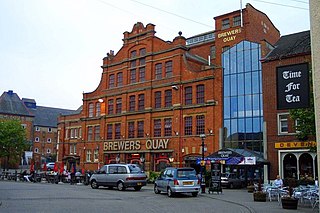
Brewers Quay is a converted Victorian brewery on the south side of Hope Square near the Old Harbour in Weymouth, Dorset, southern England. Much of the complex dates from 1903–04, when it was built as the Hope Brewery for John Groves & Sons Ltd. It was later taken over by Devenish Brewery in 1960 and opened in 1990 as an indoor shopping complex with around twenty specialty shops together with heritage and science exhibits, until it closed in 2010. From 2013-17, the building housed an antiques emporium. It currently awaits redevelopment.

The Grove is a small village located at Tophill on the Isle of Portland in Dorset. The village is found close to the larger village Easton, and is most notable for containing the Youth Offender's Institute HM Prison Portland, including its museum Grove Prison Museum. As with the rest of Portland's villages and settlements, The Grove has been designated as a conservation area, as it is a place of special architectural and historic interest. The village was designated in 1981.

Tout Quarry, now known as Tout Quarry Sculpture Park and Nature Reserve, is a sculpture park and nature reserve based within a disused quarry on the Isle of Portland, Dorset, England. It is located within the north-west corner of Tophill. The sculpture park has existed since 1983, while the site also become a nature reserve around 2004. To date, the quarry displays a collection of various carvings and works in Portland stone.

St Andrew's Church is a ruined church located above Church Ope Cove on the Isle of Portland, Dorset, England. St Andrew's was Portland's first parish church and remained as such until the mid-18th century. It is now one of the island's prime historical sites, and is a Grade II* Listed Building and a Scheduled Monument. The southern retaining wall of the churchyard is also Grade II Listed, as are three remaining churchyard monuments, approximately 7 metres south of the church.

Nothe Gardens is a public garden, located in Weymouth, Dorset, England. Positioned on the Nothe Peninsula overlooking both Weymouth and Portland harbours, the informal gardens are often acclaimed to be the most beautiful the borough has to offer.

St. Peter's Church is a former Church of England church in The Grove, on the Isle of Portland, Dorset. Designed by Major-General Sir Edmund Du Cane, the church was built in 1870-72 and is now a Grade II* Listed building. The gate piers and boundary walls to the north and west of the church are also Grade II Listed, along with the church's vicarage. St. Peter's Church is included on English Heritage's "Heritage at Risk" register.

Chiswell Walled Garden is a community walled garden, located on the Isle of Portland, Dorset, England. It is found in the village of Chiswell, close to Chesil Beach, within the remaining ruins of an old Jacobean house. The garden was created between 2001-06 by the Chiswell Community Trust, with funding from Countryside Agency under their Doorstep Green Initiative. It is maintained by volunteer members of the trust and is open to the public.

The George Inn is a Grade II-listed 18th-century public house on the Isle of Portland, Dorset, England. It is situated within the village of Easton, at the west end of the hamlet of Reforne. The pub is located close to St George's Church and St George's Centre.

The Salt Pans are two salt pans on the Isle of Portland, Dorset, England. Both pans sit next to one another, and are situated on the coastline of East Weares, the east side of Portland. The pans sit directly below the Young Offenders Institution HM Prison Portland, and are found close to various old historic relics such as the East Weare Rifle Range, Folly Pier, King's Pier and the remains of the Folly Pier Waterworks. The East Weares area, including the Salt Pans, has been labelled a Site of Special Scientific Interest (SSSI), largely due to the scrub and wildlife being of high nature conservation value.

Folly Pier Waterworks was a 19th-century waterworks on the Isle of Portland, Dorset, England. The building was located at East Weares, the east side of Portland, below HM Prison Portland, which it supplied water for. Today, only the foundations and walls of its reservoirs survive. The waterworks was named after Folly Pier, a pier once used for the transporting of Portland stone by sea.

Folly Pier is a disused stone shipping quay, located on the Isle of Portland, Dorset, England; part of the Jurassic Coast. It is found on the east side of the island within the area of East Weares. Other piers within the area include King's Pier and Durdle Pier respectively. Folly Pier dates from the 17th century.

Grove Lime Kiln is a disused 19th century lime kiln on the Isle of Portland, Dorset, England. It is located close to HM Prison Portland and The Grove village. Owned by the prison service, the lime kiln has been Grade II Listed since 2009.